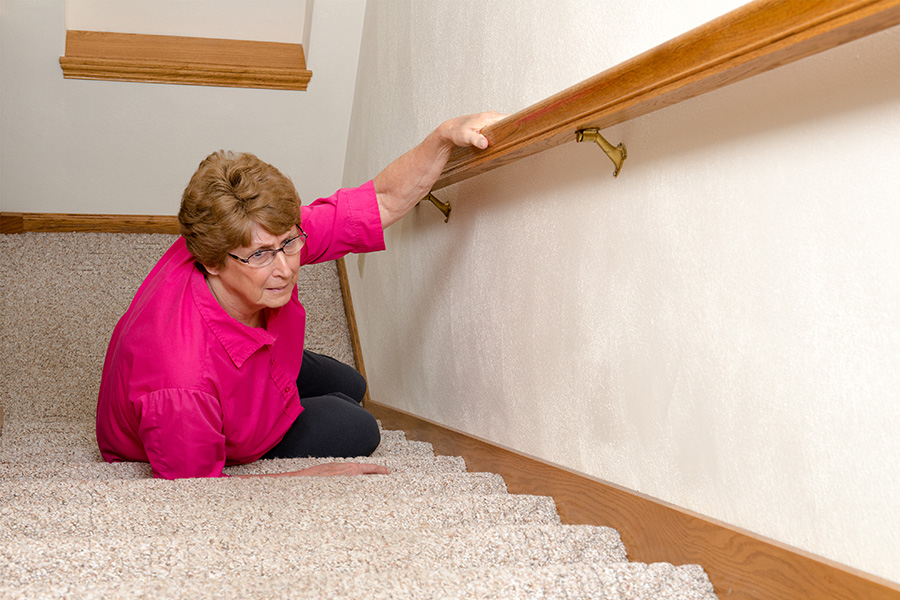The wet floor at Eastdale Mall had no warning sign. The broken sidewalk outside the Capitol Complex has been that way for months. The dim stairwell at your Montgomery apartment complex has needed a light bulb for weeks. Now you’re on the ground, pain shooting through your back, wondering if you’ll ever walk normally again. In Montgomery, property owners counting on you not knowing your rights turn preventable falls into life-changing injuries every single day. But taking the right steps immediately can mean the difference between full compensation and getting nothing at all.
Why Montgomery Slip and Falls Are More Dangerous Than You Think
Montgomery sees hundreds of serious fall injuries annually, from the Shoppes at Eastchase to downtown government buildings. These aren’t minor stumbles – falls are the leading cause of traumatic brain injuries and the second leading cause of spinal cord injuries in Alabama. What looks like a simple fall can lead to months of surgery, rehabilitation, and permanent disability.
Michael Strickland, founding attorney at Strickland Law Group with their office right here in Montgomery, has represented fall victims for over 30 years. “People apologize for ‘just’ having a slip and fall case,” he explains. “But we’ve seen falls that ended careers, destroyed retirements, and left families in financial ruin. These cases deserve the same aggressive representation as any serious injury.”
Montgomery’s unique mix of historic buildings, new construction, and weather patterns creates specific fall hazards. Heavy morning dew makes surfaces slippery. Afternoon thunderstorms flood parking lots. Old downtown buildings have uneven floors and worn stairs. New shopping centers prioritize aesthetics over safety. Each hazard requires property owners to take reasonable precautions – when they don’t, people get hurt.
Step 1: Document the Dangerous Condition Immediately (Before It Disappears)
The most critical moments after your Montgomery fall are right now. Property owners and their insurance companies will try to fix, hide, or deny the hazard that hurt you. Your phone becomes your most powerful tool for protecting your rights.
Take photos of everything – the exact spot where you fell, the surrounding area from multiple angles, your shoes and clothing, any substance or defect that caused your fall, the lighting conditions, and any warning signs (or lack thereof). Take videos walking through the area if possible, narrating what happened.
In Montgomery, specific locations require specific documentation. At Eastdale Mall or the Shoppes at Eastchase, photograph the entire store entrance and surrounding walkway. At apartment complexes like Woodland Hills or Madison Park, document stairwell lighting and handrail conditions. Downtown near Court Square, capture uneven sidewalks and construction zones. At restaurants on Atlanta Highway, photograph wet floors and entrance mats.
Get witness information immediately. Other shoppers at Walmart on South Boulevard. State employees at RSA Tower. Students at Alabama State University. These witnesses disappear quickly, but their testimony can make or break your case under Alabama’s harsh contributory negligence law.
Step 2: Report Your Fall to Create an Official Record
Never leave without reporting your fall to someone in authority. This creates a paper trail that prevents property owners from claiming the accident never happened. But be careful what you say – property owners train employees to get statements that destroy claims.
At Montgomery retail stores, insist on filling out an incident report. Don’t let employees tell you it’s unnecessary. Get a copy or photograph the report. Write down the manager’s name and any employee witnesses. Many Montgomery stores, especially national chains at Eastchase, have specific corporate procedures that must be followed.
For falls on Montgomery city property – sidewalks, parks, government buildings – call Montgomery Police or Fire Department for an official response. City claims have special requirements and shorter deadlines. You have only six months to file notice with the City of Montgomery, compared to two years for private property claims.
The experienced attorneys at Strickland Law Group warn about insurance tactics: “Property owners will call immediately, acting concerned and helpful. They’re actually gathering information to deny your claim. They’ll twist ‘I didn’t see the water’ into ‘admitted not paying attention.’ Never give recorded statements without legal representation.”
Step 3: Get Medical Treatment at a Montgomery Facility
Your health comes first, but where and how you get treatment affects your legal claim. Montgomery has several excellent medical facilities, and using local providers strengthens your case. Insurance companies use any delay in treatment to argue you weren’t really hurt.
Go to Jackson Hospital, Baptist Medical Center South, or a Montgomery urgent care immediately. Tell them exactly how you fell – slipped on a wet floor, tripped on broken pavement, fell down broken stairs. This medical documentation becomes crucial evidence linking your injuries to the property owner’s negligence.
Follow all medical advice religiously. Attend every appointment. Complete all physical therapy. Insurance companies love to argue that you failed to minimize your damages by skipping treatment. They’ll claim your ongoing problems are your fault for not following doctor’s orders.
Keep detailed records of how your injuries affect daily life. Can’t pick up your grandchildren? Missing work at Maxwell Air Force Base? Unable to attend church or ASU football games? These life impacts matter in determining compensation, but only if you document them.
Step 4: Preserve Evidence Before It’s Destroyed or Altered
Montgomery property owners move fast to eliminate evidence after falls. That spilled liquid gets mopped up. The broken tile gets repaired. Security footage gets recorded over. You need to act faster to preserve proof of dangerous conditions.
Send a preservation letter immediately to the property owner demanding they keep all security footage, incident reports, maintenance records, inspection reports, employee schedules, and previous complaint records. Strickland Law Group can send these letters with legal weight that property owners can’t ignore.
Return to the scene (safely) to document changes. If Eastdale Mall suddenly fixes the leak that caused your fall, that’s evidence they knew it was dangerous. If your Montgomery apartment complex finally replaces the broken stair after your accident, it proves the hazard existed. These “subsequent remedial measures” can be powerful evidence when handled correctly.
Social media becomes important evidence too. Check if other people have posted about falls at the same location. Montgomery community Facebook groups often discuss dangerous properties. Reviews on Google or Yelp might mention the hazard that hurt you. This evidence proves the property owner knew or should have known about the danger.
Step 5: Protect Yourself from Alabama’s Contributory Negligence Trap
Alabama’s contributory negligence law is the deadliest weapon property owners use against fall victims. Being even 1% at fault means you get nothing. Montgomery property owners and their insurance companies exploit this law ruthlessly.
Never admit fault or apologize. Saying “I should have been more careful” or “I wasn’t watching where I was going” destroys your case. Even “I’m so clumsy” can be twisted into an admission of fault. Stick to facts: “I fell because the floor was wet with no warning sign.”
Watch out for Montgomery-specific blame tactics. They’ll argue you should know the Shoppes at Eastchase gets slippery when it rains. That everyone knows downtown Montgomery sidewalks are uneven. That you assumed the risk by walking through a construction zone on Vaughn Road. These arguments prey on local knowledge to shift blame onto victims.
Be careful with surveillance footage. Many Montgomery businesses have cameras that might have captured your fall. While this can help prove dangerous conditions, it can also be used against you. Insurance companies will analyze your every move, claiming you were distracted, walking too fast, or not using handrails.
Frequently Asked Questions About Montgomery Slip and Fall Claims
What if I fell at a Montgomery government building? Falls on city or state property involve sovereign immunity issues and shorter deadlines. You must file notice within six months for city claims. State buildings like those in the RSA complex have different procedures. Government entities have immunity caps that limit recovery. You need lawyers familiar with governmental liability.
Can I sue if I fell at my Montgomery apartment? Yes, landlords must maintain safe premises. Common areas like stairs, parking lots, and walkways must be reasonably safe. Even inside your unit, landlords are responsible for dangerous conditions they knew or should have known about. Many Montgomery apartment complexes have histories of neglecting maintenance.
What if the property had a “wet floor” sign? Warning signs don’t automatically excuse dangerous conditions. The sign must be adequate and visible. If the hazard is worse than the warning suggests, or if there’s no safe alternative route, property owners remain liable. Montgomery juries understand that a tiny sign doesn’t excuse leaving puddles in walkways.
How much is my Montgomery slip and fall case worth? Value depends on injury severity, medical costs, lost wages, and the property owner’s negligence level. Montgomery juries have awarded significant verdicts for serious fall injuries. Strickland Law Group’s experience with local juries helps evaluate realistic case values. Past results include multiple six and seven-figure recoveries.
What if I was at the property for work? Falls during work might involve both workers’ compensation and premises liability claims. If you’re not an employee of the property owner, you might have a third-party claim. Delivery drivers, contractors, and visitors for business purposes have strong premises liability rights.
How long do Montgomery slip and fall cases take? Most resolve within 12-18 months, though some require trial. Montgomery Circuit Court handles these cases efficiently, but complex cases against major retailers or government entities take longer. Strickland Law Group’s trial reputation often speeds settlements because defendants know they’ll go to court if necessary.
Get Montgomery’s Experienced Slip and Fall Lawyers on Your Side
Slip and fall cases require immediate action and local expertise. Strickland Law Group’s Montgomery office understands our city’s property owners, insurance adjusters, and jury pools. They know which properties have histories of dangerous conditions and which insurance companies fight hardest against fall claims.
With over $1 billion recovered and more than 100 trials, they have the resources and experience to take on any property owner, from local landlords to national retailers. They work with engineers, safety experts, and medical professionals who can prove both dangerous conditions and injury severity.
Michael Strickland and his team at Strickland Law Group have spent decades holding negligent property owners accountable. They understand that behind every fall is a person whose life has been disrupted by someone else’s carelessness. Their aggressive approach forces property owners to take responsibility for the dangers they create.
If you’ve been injured in a slip, trip, or fall anywhere in Montgomery – from Eastdale to Eastchase, downtown to the Cloverdale area – you need immediate legal help. Call Strickland Law Group at 334-269-3230 for a free consultation. They’ll preserve evidence, meet critical deadlines, and fight Montgomery property owners who put profits over safety. Don’t let property owners and their insurance companies blame you for their negligence. Take action now to protect your rights.
Legal Disclaimer: This blog post is for informational purposes only and does not constitute legal advice. While efforts have been made to ensure accuracy regarding Montgomery-specific information and Alabama premises liability law as of 2025, laws and local ordinances can change. References to specific Montgomery locations, businesses, and properties are for illustrative purposes. The five steps outlined are general guidance and may not apply to all situations. Notice requirements for governmental entities vary and should be verified. Information about Strickland Law Group, including attorney experience, case results, office location, and contact information, should be verified directly with the firm. Past results do not guarantee future outcomes. Each slip and fall case is unique based on specific conditions and circumstances. Alabama’s contributory negligence law is complex and requires individual legal analysis. For legal advice regarding your specific slip and fall accident in Montgomery or elsewhere in Alabama, consult with a qualified premises liability attorney immediately. Time limits apply to filing claims, especially for governmental entities. No attorney-client relationship is created through reading this blog.

